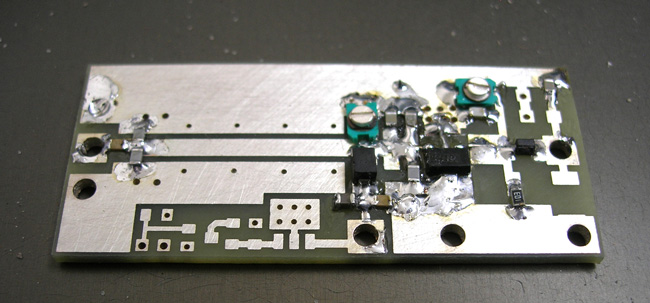Major Features
Specifications
Schematics and Pictorials
General Description
MicroHunt Mode Selection
Technical Description
More Information

More MH+33 Information
|
Major Features Specifications Schematics and Pictorials General Description MicroHunt Mode Selection Technical Description More Information |
 |
Major Features :
Specifications :
Power : 5.5 - 14 VDC ( 0.5 W out @ 5.5V )
Size : 1.0 x 2.2 inches
RF Output : 2.0 Watts minimum with 50 mW drive @ 12 VDC power
Frequency : 144 - 148 MHz
Schematics and Pictorials :
Download links to schematic diagrams and technical details for the MicroHunt +33 are provided here. For additional information about the MicroHunt +33 amplifier, inquire directly by e-mail : Bob Simmons
MH+33 schematic ( 7 Kb GIF file )
General Description :
The MH+33 is a 2 Watt / 144 MHz class C power amplifier, intended for use with the MicroHunt or SquawkBox transmitters. It provides +33 dBm output ( = 2 Watt ) with 50 milliWatts of drive, ( = +16 db gain ) with 12 VDC of power. Current draw while transmitting is typically 360 mA, and less than 1 mA when idle.
The MH+33 has an ( optional ) control input that can be used to enable/disable the amplifier, or AM-modulate it with an audio tone. This means the MH+33 amplifier ( with this option installed ) can be used with a MicroHunt transmitter for European style ARDF hunts, which typically employ A1 modulation ( on/off keyed carrier ) or A2 modulation. ( AM tone-modulated CW, with a steady carrier signal ) The MH+33 control input accepts a TTL signal with positive polarity. ( low = off, high = on ) The switching bandwidth is internally limited to about 2 KHz, to prevent excessive sideband generation.
MicroHunt transmitters shipped after 1 Jan 2006 will include software routines to enable the use of these ( optional ) MH+33 modulation features. ( mode selection is described below ) Older MicroHunt transmitters can still use the MH+33 as a straight amplifier for FM / CW operation, with no modifications. If operation with the AM modulation mode is desired, ( A1 or A2 modes ) then the microcomputer in older MicroHunt transmitters must be replaced with a new chip. ( contact me for details and fees : Bob Simmons)
MicroHunt International Mode Selection :
When employed with a MicroHunt CW transmitter, ( with modulator option installed in the MH+33 ) the operating mode of the MicroHunt transmitter can be selected with a strap that is tested by the transmitter's microcomputer, when power is applied. The test checks for the presence / absence of a jumper strap installed on pin 6 of the transmitter's microcomputer.
Technical Description :
The MH+33 amplifier is a basic class C RF amplifier, tuned for operation at 146 MHz. A stripline network is employed in the output circuit to achieve good spectral purity. Harmonics are suppressed typically 45 db or more into a 50 ohm load, across the normal DC supply range.
If the modulator option is installed, a PNP transistor in the DC supply lead ( for the RF transistor ) allows the amplifier to be turned on or off ( or AM - modulated ) from an external source. ( default = off = low control input )
More Info :
For more info or inquires, send an e-mail to Bob Simmons